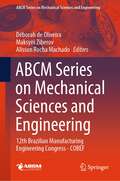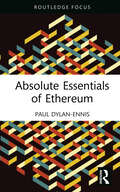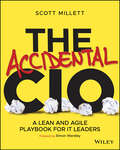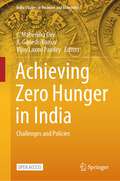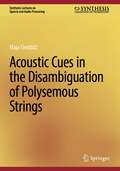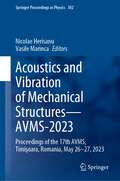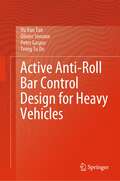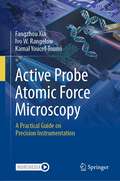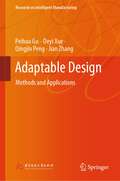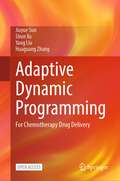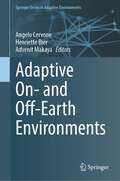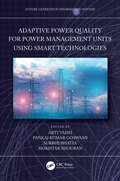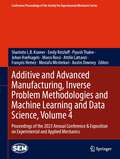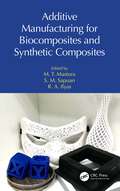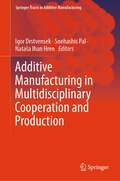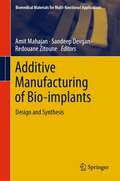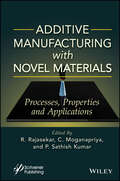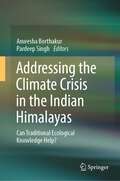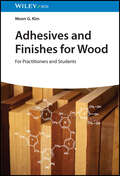- Table View
- List View
ABCM Series on Mechanical Sciences and Engineering: 12th Brazilian Manufacturing Engineering Congress - COBEF (Lecture Notes in Mechanical Engineering)
by Déborah De Oliveira Maksym Ziberov Alisson Rocha MachadoThis book presents research and findings in the field of manufacturing engineering, technologies and innovative approaches to process improvements. It features selected papers presented at 12th Brazilian Manufacturing Engineering Congress held on 10-12 of May of 2023 in Brasília, DF, Brazil. The book provides valuable insights and information to academic researchers, practicing engineers, or students just starting out in the field of manufacturing engineering. The Chapters are divided by areas of interest, including Additive Manufacturing, Processes with Material Removal, Union and Assembly Processes, Tribology and other manufacturing technologies..
Absolute Essentials of Ethereum (Absolute Essentials of Business and Economics)
by Paul Dylan-EnnisAbsolute Essentials of Ethereum is a concise textbook which guides the reader through the fascinating world of the emerging Ethereum ecosystem, from the basics of how its blockchain works to cutting-edge applications.Written by an experienced educator, each chapter is designed to progress potential students from class to class. Technical concepts are clearly explained for those new to the topic and readers are supported with definitions and summaries in each chapter. Real-life case studies situate the overviews in a contemporary context. Topics covered include the Ethereum Execution and Consensus layers, Ethereum governance and community, Decentralised Autonomous Organisations (DAOs), Decentralised Finance (DeFi), Non-Fungible Tokens (NFTs) and Layer 2.This book is the ideal text to support undergraduate and postgraduate courses on blockchain technologies, cryptocurrencies, Web3 and fintech, as well as for those who want to know how Ethereum really works.
Absolute Essentials of Ethereum (Absolute Essentials of Business and Economics)
by Paul Dylan-EnnisAbsolute Essentials of Ethereum is a concise textbook which guides the reader through the fascinating world of the emerging Ethereum ecosystem, from the basics of how its blockchain works to cutting-edge applications.Written by an experienced educator, each chapter is designed to progress potential students from class to class. Technical concepts are clearly explained for those new to the topic and readers are supported with definitions and summaries in each chapter. Real-life case studies situate the overviews in a contemporary context. Topics covered include the Ethereum Execution and Consensus layers, Ethereum governance and community, Decentralised Autonomous Organisations (DAOs), Decentralised Finance (DeFi), Non-Fungible Tokens (NFTs) and Layer 2.This book is the ideal text to support undergraduate and postgraduate courses on blockchain technologies, cryptocurrencies, Web3 and fintech, as well as for those who want to know how Ethereum really works.
The Accidental CIO: A Lean and Agile Playbook for IT Leaders
by Scott MillettAn indispensable guide showing IT leaders the way to balance the needs of innovation and exploration with exploitation and operational reliability Many books on modern IT leadership focus solely on supporting innovation and disruption. In practice these must be balanced with the need to support waste reduction in existing processes and capabilities while keeping the foundation operational, secure, compliant with regulations, and cost effective. In The Accidental CIO, veteran software developer-turned-executive Scott Millett delivers an essential playbook to becoming an impactful, strategic leader at any stage of your IT leadership journey from your earliest aspirations to long time incumbents in director and C-suite roles. You’ll find a wealth of hands-on advice for tackling the many challenges and paradoxes that face technology leaders, from creating an aligned IT strategy, defining a target architecture, designing a balanced operating model, and leading teams and executing strategy. After the foreword from Simon Wardley, The Accidental CIO will help you: Understand problem contexts you will face using the Cynefin decision making framework, and how the philosophies of agile, lean and design thinking can help manage them. Design an adaptive and strategically aligned operating model by applying the appropriate ways of working and governance approaches depending on each unique problem context. Organize a department using a blend of holacratic and hierarchical principles, and leveraging modern approaches such as Team Topology and Socio-technical patterns. Develop and deploy an effective and aligned IT Strategy using Wardley mapping based on a deep knowledge of your business architecture. With this knowledge you’ll be ready to create an empowered IT organization focused on solving customer problems and generating enterprise value. You’ll understand the science behind what motivates teams and changes behavior. And you’ll show your skills as a business leader thinking beyond IT outputs to impactful business outcomes.
The Accidental CIO: A Lean and Agile Playbook for IT Leaders
by Scott MillettAn indispensable guide showing IT leaders the way to balance the needs of innovation and exploration with exploitation and operational reliability Many books on modern IT leadership focus solely on supporting innovation and disruption. In practice these must be balanced with the need to support waste reduction in existing processes and capabilities while keeping the foundation operational, secure, compliant with regulations, and cost effective. In The Accidental CIO, veteran software developer-turned-executive Scott Millett delivers an essential playbook to becoming an impactful, strategic leader at any stage of your IT leadership journey from your earliest aspirations to long time incumbents in director and C-suite roles. You’ll find a wealth of hands-on advice for tackling the many challenges and paradoxes that face technology leaders, from creating an aligned IT strategy, defining a target architecture, designing a balanced operating model, and leading teams and executing strategy. After the foreword from Simon Wardley, The Accidental CIO will help you: Understand problem contexts you will face using the Cynefin decision making framework, and how the philosophies of agile, lean and design thinking can help manage them. Design an adaptive and strategically aligned operating model by applying the appropriate ways of working and governance approaches depending on each unique problem context. Organize a department using a blend of holacratic and hierarchical principles, and leveraging modern approaches such as Team Topology and Socio-technical patterns. Develop and deploy an effective and aligned IT Strategy using Wardley mapping based on a deep knowledge of your business architecture. With this knowledge you’ll be ready to create an empowered IT organization focused on solving customer problems and generating enterprise value. You’ll understand the science behind what motivates teams and changes behavior. And you’ll show your skills as a business leader thinking beyond IT outputs to impactful business outcomes.
Achieving Zero Hunger in India: Challenges and Policies (India Studies in Business and Economics)
by S. Mahendra Dev A. Ganesh-Kumar Vijay Laxmi PandeyThis open access volume discloses rich set of findings and policy recommendations for India towards achieving the SDG 2.1 target of zero hunger by 2030. Through its fourteen chapters, it takes an integrated approach by examining diverse aspects of food and nutrition security through multidisciplinary lens of Agricultural Economics, Nutrition, Crop Sciences, Anthropology and Law, while being rooted in economics. The chapters reflect this diversity in disciplines in terms of the questions posed, the data sets used, and the methodologies followed. Starting from the evolution of policy response for hunger and nutrition security, the book covers aspects such gender budgeting, dietary diversity, women’s empowerment, calorie intake norms, socio-legal aspects of right to health, subjective wellbeing, bio-fortification, crop insurance and food security linkages, interdependence of public distribution system (for food security) and employment guarantee schemes especially during COVID-19 pandemic, effects of dairy dietary supplements, and so on. With its rich discussions, the book is compelling for students, researchers, policy makers, development professionals and practitioners working in areas of food and nutrition security, SDGs, in particular SDG1, SDG2 and SDG5, and sustainable food systems.
Acoustic Cues in the Disambiguation of Polysemous Strings (Synthesis Lectures on Speech and Audio Processing)
by Maja GwóźdźThis book provides an analysis of acoustic features of polysemous strings and an implementation of a speech disambiguation program based on the phonetic information. Throughout the book, the term ‘polysemous string’ refers to idioms with plausible literal interpretations, restrictive and non–restrictive relative clauses, and the same expressions used as quotations and appearing in a non–quotational context. The author explains how, typically, context is sufficient to determine the intended meaning. But there is enough evidence in psycholinguistic and phonetic literature to suspect that these superficially identical strings exhibit different acoustic features. In the experiment presented in the book, the participants were asked to read short excerpts containing corresponding elements of polysemous strings placed in the same intonational position. The acoustic analyses of ditropic pairs and subsequent statistical tests revealed that there is almost no difference in the duration, pitch, or intensity in literal and figurative interpretations. However, the analysis of relative clauses and quotations demonstrated that speakers are more likely to use acoustic cues to differentiate between the two possible readings. The book argues that the acoustic analysis of polysemous phrases could be successfully implemented in designing automatic speech recognition systems in order to improve their performance in disambiguating polysemous phrases.Analyzes acoustic features of polysemous strings and an implementation of a speech disambiguation programIncludes evidence that superficially identical strings exhibit different acoustic featuresArgues that acoustic analysis of polysemous phrases can be successfully implemented in automatic speech recognition
Acoustics and Vibration of Mechanical Structures—AVMS-2023: Proceedings of the 17th AVMS, Timişoara, Romania, May 26–27, 2023 (Springer Proceedings in Physics #302)
by Nicolae Herisanu Vasile MarincaThis book presents peer-reviewed and selected papers from the 17th Conference on Acoustics and Vibration of Mechanical Structures (AVMS) held in Timisoara, Romania, on 26–27 May 2023. Internationally recognized experts share their knowledge and key findings in a broad range of topics related to acoustics and vibration of mechanical structures such as analytical, numerical and experimental techniques for noise and vibration problems, environmental and occupational noise and vibration, modelling, prediction and simulations of noise and vibration, noise and vibration control, noise and vibration attenuators. The book addresses application studies and fundamental studies as well, and it is meant for academics researchers and professionals, as well as Ph.D. students concerned with various fields of acoustics and vibration of mechanical structures.
Active Anti-Roll Bar Control Design for Heavy Vehicles
by Vu Van Tan Olivier Sename Peter Gaspar Trong Tu DoThis book provides a comprehensive overview of active anti-roll bar systems on heavy vehicles as one of the most effective solutions for improving the roll stability of these vehicles. Due to the characteristics of these vehicles with heavy loads and high center of gravity, the possibility of roll instability occurs frequently and causes serious consequences for human life, vehicles, and traffic infrastructure. The book gives readers an in-depth survey of the roll instability characteristics of heavy vehicles such as single-unit trucks with rigid and flexible frames, and tractor semi-trailers. It then introduces an active anti-roll bar system, the electro-hydraulic actuators which use control methods such as LQR optimal and H∞ robust controller design. This work introduces a new control method, which is a combination of robust control with the linear parameter varying system (H∞/LPV). The validation of the new hybrid method is carried out using the nonlinear truck model from the TruckSim® software to assess the roll stability of heavy vehicles in order to limit the rollover accident. A number of examples are provided to illustrate the research results, which helps the readers have a practical and easy approach that can be applied to other active anti-roll bar systems for most forms of transport vehicles in general. This book caters to academics and practitioners who are interested in active anti-roll bar systems for the typical heavy vehicle available worldwide.
Active Probe Atomic Force Microscopy: A Practical Guide on Precision Instrumentation
by Fangzhou Xia Ivo W. Rangelow Kamal Youcef-ToumiFrom a perspective of precision instrumentation, this book provides a guided tour to readers on exploring the inner workings of atomic force microscopy (AFM). Centered around AFM, a broad range of mechatronic system topics are covered including mechanics, sensors, actuators, transmission design, system identification, signal processing, dynamic system modeling, controller. With a solid theoretical foundation, practical examples are provided for AFM subsystem level design on nano-positioning system, cantilever probe, control system and system integration. This book emphasizes novel development of active cantilever probes with embedded transducers, which enables new AFM capabilities for advanced applications. Full design details of a low-cost educational AFM and a Scale Model Interactive Learning Extended Reality (SMILER) toolkit are provided, which helps instructors to make use of this book for curriculum development. This book aims to empower AFM users with deeper understanding of the instrument to extend AFM functionalities for advanced state-of-the-art research studies. Going beyond AFM, materials presented in this book are widely applicable to precision mechatronic system design covered in many upper-level graduate courses in mechanical and electrical engineering to cultivate next generation instrumentalists.
Adaptable Design: Methods and Applications (Research on Intelligent Manufacturing)
by Peihua Gu Deyi Xue Qingjin Peng Jian ZhangThis book provides a comprehensive discussion of Adaptable Design (AD). It covers the conception, method, and application of AD to the real-world product design. AD's benefits are substantial as it upgrades, reuses, remanufactures and recycles products throughout the product lifecycle. It rapidly adapts the existing design in development of new designs. Key elements of AD include rationalized function structures, adaptable product architectures, adaptable interfaces, and adaptability evaluations. The main feature of AD is adaptability in design methods and product applications with general and specific adaptability. AD has also modeling and evaluating adaptabilities.
Adaptive Dynamic Programming: For Chemotherapy Drug Delivery
by Jiayue Sun Shun Xu Yang Liu Huaguang ZhangThis open access book focuses on the practical application of Adaptive Dynamic Programming (ADP) in chemotherapy drug delivery, taking into account clinical variables and real-time data. ADP's ability to adapt to changing conditions and make optimal decisions in complex and uncertain situations makes it a valuable tool in addressing pressing challenges in healthcare and other fields. As optimization technology evolves, we can expect to see even more sophisticated and powerful solutions emerge.
Adaptive On- and Off-Earth Environments (Springer Series in Adaptive Environments)
by Angelo Cervone Henriette Bier Advenit MakayaThis volume investigates the challenges and opportunities for designing, manufacturing and operating off-Earth infrastructures in order to establish adaptive human habitats. The adaptive aspects are considered with respect to the development of adequate infrastructures designed to support human activities. Given the limitations in bringing materials from Earth, utilisation of in-situ resources is crucial for establishing and maintaining these infrastructures.Adaptive on-and off-Earth Environments focuses, among other aspects, on the design, production, and operation processes required to build and maintain such off-Earth infrastructures, while heavily relying on In-Situ Resource Utilisation (ISRU). Such design, production, and operation processes integrate cyber-physical approaches developed and tested on Earth. The challenge is to adapt on-Earth approaches to off-Earth applications aiming at technology advancement and ultimately transfer from on- to off-Earth research. Thischallenge is addressed with contributions from various disciplines ranging from power generation to architecture, construction, and materials engineering involving ISRU for manufacturing processes. All chapters, related to these disciplines, are structured with an emphasis on computing and adaptivity of on-Earth technology to off-Earth applications and vice versa to serve society at large.
Adaptive Power Quality for Power Management Units using Smart Technologies (Future Generation Information Systems)
by Arti Vaish Pankaj Kumar Goswami Surbhi Bhatia Mokhtar ShouranThis book covers issues associated with smart systems due to the presence of onboard nonlinear components. It discusses the advanced architecture of smart systems for power management units. It explores issues of power management and identifies hazardous signals in the power management units of smart devices. It Presents adaptive artificial intelligence and machine learning-based control strategies. Discusses advanced simulations and data synthesis for various power management issues. Showcases solutions to the uncertainty and reliability issues in power management units. Identifies new power quality challenges in smart devices. Explains hybrid active power filters, shunt hybrid active power filters, and the industrial internet of things in power quality management. This book comprehensively discusses advancements of traditional electrical grids, the benefits of smart grids to customers and stakeholders, properties of smart grids, smart grid architecture, smart grid communication, and smart grid security. It further covers the architecture of advance power management units (PMU) of smart devices, and the identification of harmonic distortions with respect to various sensor-based technology. It will serve as an ideal reference text for senior undergraduate and graduate students, and academic researchers in fields including electrical engineering, electronics, communications engineering, and computer engineering.
Adaptive Power Quality for Power Management Units using Smart Technologies (Future Generation Information Systems)
by Arti Vaish Pankaj Kumar Goswami Surbhi Bhatia Mokhtar ShouranThis book covers issues associated with smart systems due to the presence of onboard nonlinear components. It discusses the advanced architecture of smart systems for power management units. It explores issues of power management and identifies hazardous signals in the power management units of smart devices. It Presents adaptive artificial intelligence and machine learning-based control strategies. Discusses advanced simulations and data synthesis for various power management issues. Showcases solutions to the uncertainty and reliability issues in power management units. Identifies new power quality challenges in smart devices. Explains hybrid active power filters, shunt hybrid active power filters, and the industrial internet of things in power quality management. This book comprehensively discusses advancements of traditional electrical grids, the benefits of smart grids to customers and stakeholders, properties of smart grids, smart grid architecture, smart grid communication, and smart grid security. It further covers the architecture of advance power management units (PMU) of smart devices, and the identification of harmonic distortions with respect to various sensor-based technology. It will serve as an ideal reference text for senior undergraduate and graduate students, and academic researchers in fields including electrical engineering, electronics, communications engineering, and computer engineering.
Additive and Advanced Manufacturing, Inverse Problem Methodologies and Machine Learning and Data Science, Volume 4: Proceedings of the 2023 Annual Conference & Exposition on Experimental and Applied Mechanics (Conference Proceedings of the Society for Experimental Mechanics Series)
by Sharlotte L. B. Kramer Emily Retzlaff Piyush Thakre Johan Hoefnagels Marco Rossi Attilio Lattanzi François Hemez Mostafa Mirshekari Austin DowneyAdditive and Advanced Manufacturing, Inverse Problem Methodologies and Machine Learning and Data Science, Volume 4 of the Proceedings of the 2023 SEM Annual Conference & Exposition on Experimental and Applied Mechanics, the fourth volume of five from the Conference, brings together contributions to this important area of research and engineering. The collection presents early findings and case studies on a wide range of topics and includes papers in the following general technical research areas: AM Composites and Polymers Dynamic Behavior of Additively Manufactured Materials and Structures Joint Residual Stress and Additive Manufacturing ML for Material Model Identification Novel AM Structures Novel Processing and Testing of Additively Manufactured Materials Plasticity and Complex Material Behavior Virtual Fields Method
Additive Manufacturing for Biocomposites and Synthetic Composites
by M. T. Mastura S. M. Sapuan R. A. IlyasAdditive Manufacturing for Biocomposites and Synthetic Composites focuses on processes, engineering, and product design applications of bio-composites and synthetic composites in additive manufacturing (AM). It discusses the preparation and material characterization and selection, as well as future opportunities and challenges. Reviews the latest research on the development of composites for AM and the preparation of composite feedstocks Offers an analytical and statistical approach for the selection of composites for AM, including characterization of material properties Emphasizes the use of environmentally friendly composites Analyzes the lifecycle including costs Considers potential new fibers, their selection, and future applications This book provides a comprehensive overview of the application of advanced composite materials in AM and is aimed at researchers, engineers, and advanced students in materials and manufacturing engineering and related disciplines.
Additive Manufacturing for Biocomposites and Synthetic Composites
by M. T. Mastura S. M. Sapuan R. A. IlyasAdditive Manufacturing for Biocomposites and Synthetic Composites focuses on processes, engineering, and product design applications of bio-composites and synthetic composites in additive manufacturing (AM). It discusses the preparation and material characterization and selection, as well as future opportunities and challenges. Reviews the latest research on the development of composites for AM and the preparation of composite feedstocks Offers an analytical and statistical approach for the selection of composites for AM, including characterization of material properties Emphasizes the use of environmentally friendly composites Analyzes the lifecycle including costs Considers potential new fibers, their selection, and future applications This book provides a comprehensive overview of the application of advanced composite materials in AM and is aimed at researchers, engineers, and advanced students in materials and manufacturing engineering and related disciplines.
Additive Manufacturing for Construction
by Biranchi Panda Pshtiwan N. Shakor Vittoria LaghiAdditive Manufacturing for Construction reveals additive manufacturing technologies for building and construction applications. It introduces digital and multiuse technologies for civil applications and informs the reader of their design properties and uses. The book explores on-site and off-site construction techniques, and features design strategies in additive manufacturing which will eliminate production difficulties and minimise assembly costs, from both the academic and the industrial perspectives. The unique capabilities of additive manufacturing technologies for large-scale applications combined with 'design for manufacturing' strategies are shown, allowing the reader to understand efficient structural shapes and forms which can provide appropriate level of structural performance with reduced use of materials and resources. This book gathers knowledge of multidisciplinary investigations into one book to answer challenges and difficulties faced by the construction industry and includes: extrusion-based concrete additive manufacturing particle bed additive manufacturing shotcrete additive manufacturing wire-and-arc metal additive manufacturing simulation modelling of concrete 3D printing Additive Manufacturing for Construction is of interest to those in academia and industry including architects, civil engineers, material engineers, manufacturing and industrial engineers, mechatronic engineers and construction experts with an interest/professional requirement to know about large-scale additive manufacturing technologies.
Additive Manufacturing in Multidisciplinary Cooperation and Production (Springer Tracts in Additive Manufacturing)
by Igor Drstvensek Snehashis Pal Nataša Ihan HrenThis book publishes the latest findings and ideas in the field of additive manufacturing presented by authors from prominent institutions around the world at the iCAT 2023 conference. The authors address various technological and medical aspects, ranging from materials science to the specific behaviour of the technology under different working conditions. The book is divided into four sections, three of which are dedicated to the purely technological aspects of additive manufacturing, covering metal processes, polymer processes and simulation. The fourth part of the book is dedicated to the medical applications of additive manufacturing, covering areas ranging from orthopaedic surgeries to materials used in medical AM.Overall, the book provides insight into the current state of the science and applications of additive manufacturing.
Additive Manufacturing of Bio-implants: Design and Synthesis (Biomedical Materials for Multi-functional Applications)
by Amit Mahajan Sandeep Devgan Redouane ZitouneThis contributed volume presents the latest research on additive manufacturing (AM) or 3D printing, one of the key techniques of novel medical devices, which can process complicated or customized structures to match the properties of human tissues. AM allows for the fabrication of devices with optimal architectures, complicated morphologies, surface integrity, and regulated porosity and chemical composition. Various AM methods can now consistently fabricate dense products for a variety of materials, comprising steels, titanium alloys, Co-Cr alloys, metal-based composites, and nanocomposites. This book elucidates the chronology of various techniques that are categorized under additive manufacturing. Moreover, the futuristic techniques or advancements in this area are also described. The available literature focuses on the microstructure and various properties of 3D-printed alloys. However, the research on the wear characteristics, corrosion resistance, and biocompatibility of 3D-printed technology for biomedical applications is limited. This book comprises the helicopter view of different surface analysis trends of additive manufactured alloys. The book can be a valuable reference for beginners, researchers, and professionals interested in bioimplant manufacturing and allied fields.
Additive Manufacturing with Novel Materials: Process, Properties and Applications
by R. Rajasekar C. Moganapriya P. Sathish KumarADDITIVE MANUFACTURING With NOVEL MATERIALS The book explores practically the latest advancements and techniques in 3D and 4D printing using innovative and unconventional materials. This book comprehensively provides insights into various additive manufacturing processes, novel materials, and their properties, as well as the basic knowledge of AM process parameters, post-processing techniques, and their applications. It also explores the fundamental concepts and recent advancements in the development of novel materials for several applications, with special emphasis on platforms like AM techniques for polymers, ceramics, metallic materials, composites, nanomaterials, hydrogels, etc. Specific topics like environmental aspects of 3D printing and advanced 4D printing are also introduced. The technological aspects of AM are discussed in a concise and understandable way, with extensive illustrations. Also covered are the challenges and opportunities that arise from 3D printing with these materials. Audience The book will benefit researchers and industry engineers who work in additive manufacturing, mechanical engineering, 3D/4D printing, and materials science.
Additive Manufacturing with Novel Materials: Process, Properties and Applications
by R. Rajasekar C. Moganapriya P. Sathish KumarADDITIVE MANUFACTURING With NOVEL MATERIALS The book explores practically the latest advancements and techniques in 3D and 4D printing using innovative and unconventional materials. This book comprehensively provides insights into various additive manufacturing processes, novel materials, and their properties, as well as the basic knowledge of AM process parameters, post-processing techniques, and their applications. It also explores the fundamental concepts and recent advancements in the development of novel materials for several applications, with special emphasis on platforms like AM techniques for polymers, ceramics, metallic materials, composites, nanomaterials, hydrogels, etc. Specific topics like environmental aspects of 3D printing and advanced 4D printing are also introduced. The technological aspects of AM are discussed in a concise and understandable way, with extensive illustrations. Also covered are the challenges and opportunities that arise from 3D printing with these materials. Audience The book will benefit researchers and industry engineers who work in additive manufacturing, mechanical engineering, 3D/4D printing, and materials science.
Addressing the Climate Crisis in the Indian Himalayas: Can Traditional Ecological Knowledge Help?
by Anwesha Borthakur Pardeep SinghThis book focuses on the traditional ecological knowledge in addressing the current climate crisis in the Indian Himalayas. Local or indigenous people in the Himalayas, through their low-carbon producing lifestyles, contribute very little to the climate crisis. However, at the same time, they bear the brunt of this crisis way more than many others. It is important to learn about their traditional ways of life and the knowledge that they hold regarding ecology and environment. Traditional ecological knowledge and associated belief systems are given increasing attention across the globe in recent times toward addressing some of the grave environmental concerns. Climate change is one such concern. The rising consideration of concepts such as ethnoecology and ethnobotany signifies the scientific, socio-cultural and economic potential of the traditional ecological knowledge systems. It is indisputable that these knowledge systems have the ability to provide important insights towards tackling many present-day environmental distresses including several climate change challenges. In this book, the authors concentrate on such traditional ecological knowledge systems in the Indian Himalayan region and try to figure out their significance in relation to the modern science. Overall, the authors attempt to write a book where the relevance of traditional ecological knowledge systems could be addressed and communicated to a larger audience—both academic scientific and non-academic.
Adhesives and Finishes for Wood: For Practitioners and Students
by Moon G. KimAdhesives and Finishes for Wood Understand the science of joining wood with this comprehensive guide Long seen as an old-fashioned material with narrowing modern applications, wood has seen increased popularity as a material in building and manufacturing in recent years. This has been driven by the need for sustainable resources and environmentally friendly materials. As a result of increased emphasis on wood, however, there is a corresponding need to understand the wood adhesives, the crucial materials in wood-based manufacture and craftsmanship. Adhesives and Finishes for Wood meets this need with a comprehensive but accessible introduction to the chemistry and applications of wood adhesives. Its easy-to-follow presentation nonetheless presents wood adhesives and finishes in significant detail. Ideal for readers without considerable preexisting knowledge in chemistry, this book includes everything the reader needs to understand and apply wood adhesives in their work or industry. Adhesives and Finishes for Wood readers will also find: Coverage ranging from the fundamentals of wood adhesive polymer chemistry to the properties of specific wood structures and resins A presentation suitable for both academic students and wood manufacture professionals An author with decades of experience in both academia and industry Adhesives and Finishes for Wood is a useful reference for advanced students and professionals in industries or manufacturing disciplines that incorporate wood, as well as for chemists, materials scientists, vocational school instructors, and more.
